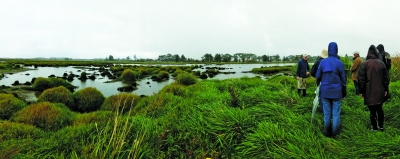Wairio on show
About 30 people braved squally rain on Sunday, May 9, for a guided tour of Wairio Wetland led by Ducks Unlimited NZ President Ross Cottle and Director Jim Law.
The event was a Rural Women New Zealand annual event to raise money for the Associated Country Women of the World to help fund community projects in developing countries.
Before setting out, Ross and Jim told the visitors about DU’s long involvement with the wetland – from Stage 1, its initial project about 17 years ago through to the latest development in Stage 4.
Ross said the wetland’s only water source in 2005 was courtesy of high wind dumping water into it from Lake Wairarapa to the west, but it didn’t retain it, and the water flowed straight back into the lake.
DU put in a bund wall, which was moderately successful, holding the water through the bird breeding season, but by December, it had dried out.
The next step was to dig down to a lower level to keep the water there longer, which was more successful, holding the water till the birds had bred and fledged. At the same time, DU planted out native species and these are now well established in Stage 1.
From there, it was on to Stage 2 and 3, and every low spot was fenced off with a bund wall.
Stage 3 was handed over to Victoria University because “we wanted some science behind it”, Ross said. It was envisaged that the project would provide a template for wetland restoration.
“Next thing, someone had a bright idea to put in a bund wall” between the three stages and the lake. About two weeks later, a mighty wind blew water in from the lake and “we had 100 acres of water”. After that success, DU extended the bund all the way back to Stage 1.
This was “amazingly successful” and has created a wetland of more than 250 acres of water.
“We were successful beyond our wildest dreams,” Ross said.
Jim said Wairio had been a ground- breaking project, with the Department of Conservation handing over the wetland’s management to DU – at the time it was unheard of for DOC to hand over restoration of its land to a local group.
“It only took us two years to convince DOC to let us spend our money on their land.”
DU has spent more than $200,000 in the past 17 years. About half of this has come from donations, which began rolling in once people saw how Wairio was being transformed and the return of wildlife.
On the 4.2km walk, Jim led the visitors along the bund wall track through Stage 4 of the wetland, where he described DU’s vision of the future – when stands of kahikatea would replace the current open areas of fescue.
With a rainbow in the background, and Ross bringing up the rear in his side-by-side to assist any stragglers, the tour covered Stages 3 and 2 before reaching its conclusion at Stage 1.
On a small detour from the main track to the water’s edge at Stage 4, the group had a preview of the proposed site for a viewing hide which DU has built. It is now waiting for a resource consent to place it on the site.
Birdlife has flourished at Wairio since DU took over, and the number of royal spoonbills, which previously had not been seen for 30 years, have surpassed 100, and they are breeding there.
Bittern numbers have remained stable in the past four or five years, despite a continuing decline throughout the rest of New Zealand.
Over a hot cuppa back at the cars, the visitors said the tour had been a revelation and they were highly impressed with their tour guides’ continuing passion and enthusiasm for the project.
Image Gallery
https://ducks.org.nz/flight-magazine/item/418-wairio-on-show#sigProId5b287297ff


